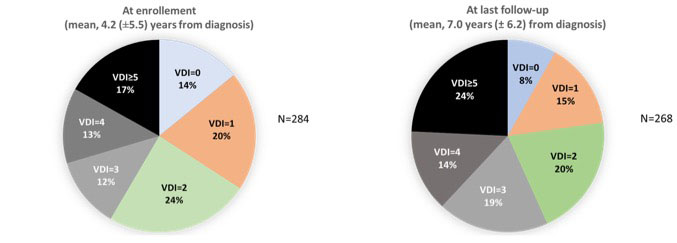Session Information
Session Type: Poster Session (Tuesday)
Session Time: 9:00AM-11:00AM
Background/Purpose: Eosinophilic granulomatosis with polyangiitis (EGPA) is characterized by asthma and other manifestations of vasculitis, some of which can be life-threatening, cause major organ damage, or become chronic. Data on damage in EGPA is limited, mainly due to the rarity of the disease. This study aimed at describing damage in patients with EGPA enrolled in the Vasculitis Clinical Research Consortium (VCRC).
Methods: Retrospective analysis of damage in patients with EGPA participating in the VCRC Longitudinal Study (LS) or One-Time DNA (OT) studies from 2003-2019. Patients were ≥18 years of age at enrollment and fulfilled the modified American College of Rheumatology 1990 criteria. Data elements included demographics, ANCA status, use of cyclophosphamide (CYC), cumulative duration of glucocorticoid (GC) use, relapses, all items of the Vascular Damage Index (VDI). VDI is a validated, cumulative damage score, which includes 64 items, grouped by organ or system and each scoring 1 point (range, 0-64; by design, VDI is 0 at diagnosis). VDI scores and items were analyzed at enrollment (for all patients with a diagnosis made >3 months prior to enrollment, and at the farthest visit from diagnosis for patients with a follow-up >1-year post-diagnosis. For the last VDI score, associations of age, sex, CYC use, duration of GC use, and relapses with accrual of damage were explored.
Results: The cohort included 354 patients, of which 336 had a follow-up post-diagnosis >3 months. Mean age at diagnosis for the latter was 50.0 (SD ±14.1) years; 197 (58.6%) were female. Of those tested for ANCA, 132 (42.7%) were positive. A total of 112 (41.9%) LS patients received CYC at some point during their disease; mean duration of GC use was 13.7 (±20.7) months. With a mean follow-up from diagnosis for all 336 patients of 7.2 (±6.1) years, 173 (51.4%) had at least one relapse. VDI at enrollment (for the 284 patients enrolled >3 months’ post-diagnosis; mean 4.2 (±5.5) years from diagnosis), and last follow-up visit for patients with >1 year of follow-up post-diagnosis (n=268) were 2.61 (±2.17) and 3.19 (± 2.24), respectively. VDI score distributions and items for the latter are showed in Figures 1 and 2. Univariate analysis of data from the 128 LS patients with a follow-up post-diagnosis >1 year identified male sex, older age, longer duration of GC use, and having relapsed as significantly associated with higher VDI at last visit. Multivariate Poisson regression analysis retained only male sex (mean VDI of 3.80 ±0.31 in male vs. 3.0 ±0.23 in female patients; P< 0.01) and longer duration of GC use (increase of the VDI by 0.5% for each additional month of GC use; P< 0.01) as being associated with a higher last VDI.
Conclusion: Patients with EGPA accumulate substantial permanent damage from the disease and treatment, even several years after diagnosis. Strategies to attain sustained, long-term limitation of damage should be important aspects of the management of patients with EGPA. Identification of more effective and safer treatments for EGPA are needed, especially to limit the use of GC.
To cite this abstract in AMA style:
Doubelt I, Cuthbertson D, Tomasson G, Carette S, Khalidi N, Koening C, Langford C, McAlear C, Moreland L, Monach P, Seo P, Specks U, Sreih A, Young K, Ytterberg S, Merkel P, Pagnoux C, Vasculitis Clinical Research Consortium V. The Cumulative Burden of Damage for Patients with Eosinophilic Granulomatosis with Polyangiitis [abstract]. Arthritis Rheumatol. 2019; 71 (suppl 10). https://acrabstracts.org/abstract/the-cumulative-burden-of-damage-for-patients-with-eosinophilic-granulomatosis-with-polyangiitis/. Accessed .« Back to 2019 ACR/ARP Annual Meeting
ACR Meeting Abstracts - https://acrabstracts.org/abstract/the-cumulative-burden-of-damage-for-patients-with-eosinophilic-granulomatosis-with-polyangiitis/


